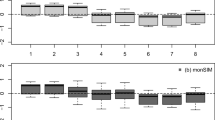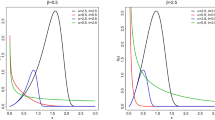Abstract
Multivariate Conditional Transformation Models (MCTMs) were recently proposed as a new multivariate regression technique. These models characterize jointly the covariates effects on the marginal distributions of the responses and their correlations without requiring parametric assumptions. Flexibility, in both the responses and covariates effects are achieved using Bernstein basis polynomials. In this paper we compare MCTMs estimations with the well established Copula Generalized Additive Models (CGAMLSS). MCTMs conditional correlation estimations outperform the CGAMLSS ones, showing lower estimation error, and variability. Finally, MCTMs were applied to the joint modelling of three thyroid hormones concentrations – Thyroid Stimulating Hormone (TSH), triiodothyronine (T3), and thyroxine (T4) – conditionally on age. Our results show how the marginal distribution and correlations of the hormones concentrations are influenced by the age of the patients.
Supported by Grant from the Program of Aid to the Predoctoral Stage (ED481A-2018/154) of the Galician Regional Authority (Consellería de Cultura, Educación e Ordenación Universitaria, Xunta de Galicia) and European Social Fund 2014/2020. Developed under the project MTM2017-83513-R and co-financed by the Ministry of Economy and Competitiveness (SPAIN) and by the European Regional Development Fund (ERDF). Also supported by the project ED431C 2020/20, financed by the Competitive Research Unit Consolidation 2020 Programme of the Galician Regional Authority (Xunta de Galicia).
Access this chapter
Tax calculation will be finalised at checkout
Purchases are for personal use only
Similar content being viewed by others
References
Duarte, E., et al.: Applying spatial copula additive regression to breast cancer screening data. In: Gervasi, O., et al. (eds.) ICCSA 2017. LNCS, vol. 10405, pp. 586–599. Springer, Cham (2017). https://doi.org/10.1007/978-3-319-62395-5_40
Espasandín-Domínguez, J.: Assessing the relationship between markers of glycemic control through flexible copula regression models. Stat. Med. 38(27), 5161–5181 (2019). https://doi.org/10.1002/sim.8358
Espasandín-Domínguez, J., et al.: Bivariate copula additive models for location, scale and shape with applications in biomedicine. In: Gil, E., Gil, E., Gil, J., Gil, M.Á. (eds.) The Mathematics of the Uncertain. SSDC, vol. 142, pp. 135–146. Springer, Cham (2018). https://doi.org/10.1007/978-3-319-73848-2_13
Hadlow, N.C., Rothacker, K.M., Wardrop, R., Brown, S.J., Lim, E.M., Walsh, J.P.: The relationship between TSH and free T4 in a large population is complex and nonlinear and differs by age and sex. J. Clin. Endocrinol. Metab. 98(7), 2936–2943 (2013). https://doi.org/10.1210/jc.2012-4223
Hoermann, R., Eckl, W., Hoermann, C., Larisch, R.: Complex relationship between free thyroxine and TSH in the regulation of thyroid function. Eur. J. Endocrinol. 162(6), 1123–1129 (2010). https://doi.org/10.1530/EJE-10-0106
Hoermann, R., Larisch, R., Dietrich, J.W., Midgley, J.E.: Derivation of a multivariate reference range for pituitary thyrotropin and thyroid hormones: diagnostic efficiency compared with conventional single-reference method. Eur. J. Endocrinol. 174(6), 735–743 (2016). https://doi.org/10.1530/EJE-16-0031
Jonklaas, J., Razvi, S.: Reference intervals in the diagnosis of thyroid dysfunction: treating patients not numbers. Lancet Diab. Endocrinol. 7(6), 473–483 (2019). https://doi.org/10.1016/S2213-8587(18)30371-1
Klein, N., Hothorn, T., Barbanti, L., Kneib, T.: Multivariate conditional transformation models. Scand. J. Stat. (2019). https://doi.org/10.1111/sjos.12501
Kumar, M.S., Safa, A.M., Deodhar, S.D., Schumacher, O.P.: The relationship of thyroid-stimulating hormone (TSH), thyroxine (T4), and triiodothyronine (T3) in primary thyroid failure. Am. J. Clin. Pathol. 68(6), 747–751 (1977). https://doi.org/10.1093/ajcp/68.6.747
Marra, G., Radice, R.: Bivariate copula additive models for location, scale and shape. Comput. Stat. Data Anal. 112, 99–113 (2017). https://doi.org/10.1016/j.csda.2017.03.004
Spencer, C., LoPresti, J., Patel, A., Guttler, R., Eigen, A., Shen, D., Gray, D., Nicoloff, J.: Applications of a new chemiluminometric thyrotropin assay to subnormal measurement. J. Clin. Endocrinol. Metab. 70(2), 453–460 (1990). https://doi.org/10.1210/jcem-70-2-453
Taylor, P.N., et al.: Global epidemiology of hyperthyroidism and hypothyroidism. Nat. Rev. Endocrinol. 14(5), 301 (2018). https://doi.org/10.1038/nrendo.2018.18
UCLA Endocrine Center (UCLA Health): What are normal thyroid hormone levels? (nd). https://www.uclahealth.org/endocrine-center/normal-thyroid-hormone-levels#:~:text=TSH%20normal%20values%20are%200.5%20to%205.0%20mIU%2FL. Accessed 15 June 2021
Author information
Authors and Affiliations
Corresponding author
Editor information
Editors and Affiliations
Rights and permissions
Copyright information
© 2021 Springer Nature Switzerland AG
About this paper
Cite this paper
Díaz-Louzao, C., Lado-Baleato, Ó., Gude, F., Cadarso-Suárez, C. (2021). Multivariate Conditional Transformation Models. Application to Thyroid-Related Hormones. In: Gervasi, O., et al. Computational Science and Its Applications – ICCSA 2021. ICCSA 2021. Lecture Notes in Computer Science(), vol 12949. Springer, Cham. https://doi.org/10.1007/978-3-030-86653-2_25
Download citation
DOI: https://doi.org/10.1007/978-3-030-86653-2_25
Published:
Publisher Name: Springer, Cham
Print ISBN: 978-3-030-86652-5
Online ISBN: 978-3-030-86653-2
eBook Packages: Computer ScienceComputer Science (R0)




